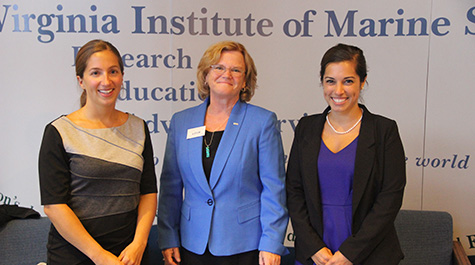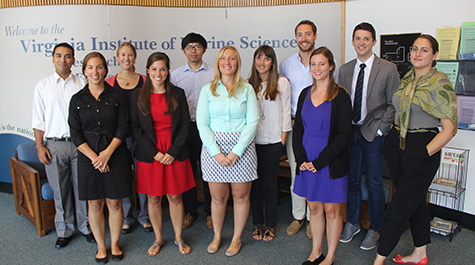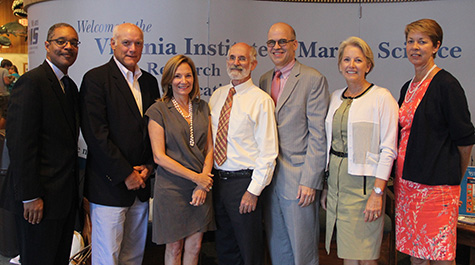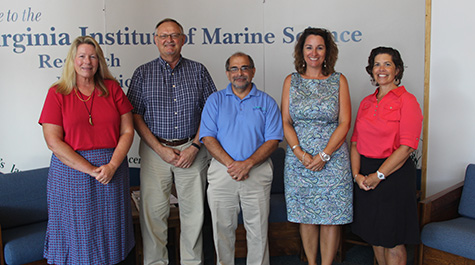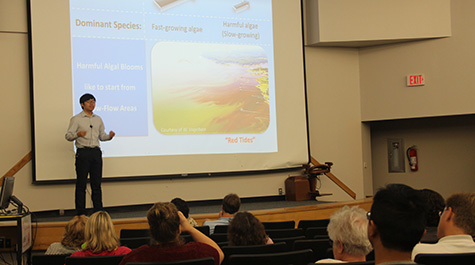VIMS names winners in annual Three Minute Thesis competition
Graduate student Bianca Santos of the Virginia Institute of Marine Science won first-place and the People’s Choice Award during the second annual Three Minute Thesis® competition at VIMS.
Santos—a second-year Master’s student—introduced an audience of peers, faculty, and special guests to the puzzling cold case she is attempting to crack in her thesis research. Distilling a multi-year project into a 3-minute presentation titled Sea Turtle CSI, Santos explained how she is trying to determine the locations where sea turtles are dying in Chesapeake Bay, and the factors in those areas that may be contributing to the deaths, such as interaction with fishing gear or cold water temperatures.
During her presentation, Santos compared her research to a detective investigating a murder, leading the audience step-by-step through the who, what, where, when, and why of sea turtle mortality in Bay waters. “My research will provide focus areas for conservation and help designate protected areas for sea turtles in the Bay,” she says.
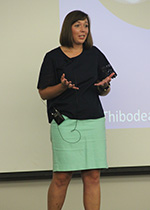 Santos was 1 of 13 graduate students from William & Mary’s School of Marine Science at VIMS who participated in this popular annual event. Established by The University of Queensland (UQ) in 2008, 3MT® has become a tradition in more than 200 universities across more than 18 countries worldwide.
Santos was 1 of 13 graduate students from William & Mary’s School of Marine Science at VIMS who participated in this popular annual event. Established by The University of Queensland (UQ) in 2008, 3MT® has become a tradition in more than 200 universities across more than 18 countries worldwide.
The semi-final round of the VIMS competition—held on the previous day—showcased the diverse research interests of the graduate students at VIMS. Topics ranged from Harmful Algal Blooms, eels, and alien predators to DNA and Antarctic sea butterflies.
VIMS Associate Dean of Academic Studies Linda Schaffner says the competition gives the participants the opportunity to share their research at a level that more people can understand. “In addition to having enough time to present a rigorous justification of their research, the format leaves enough time for speakers to convey their excitement of pursuing research and the importance of advancing science.”
Six of the original 13 participants were chosen to advance to the final round on the evening of September 10th, during which the selected speakers gave their presentations a second time. A panel of seven distinguished judges determined the first-and second-place winners, who were announced to the waiting audience moments later.
Second place in the competition was Ph.D. student Nadya Mamoozadeh, who introduced the audience to her research on the “magic of DNA.” Mamoozadeh is comparing the DNA from marlin sampled in multiple geographic regions, in an effort to determine which groups of marlin are genetically similar or dissimilar—evidence of whether they belong to the same breeding population.
“The end result of my research is understanding the number of marlin populations in an ocean,” she says. “Fisheries managers will then be able to promote the sustainability of each marlin population, prevent the unintentional overfishing of some populations in comparison to others, and maintain genetic diversity critical for withstanding disease and environmental fluctuations.”
“The ability to effectively communicate science with public audiences is increasingly recognized as an essential skill for scientists at all career stages,” says Schaffner. “Communication skills can make a real difference in today’s job market where employers need marine scientists who can build bridges to diverse stakeholders—from policy makers and resource managers to the fishing community and general public.”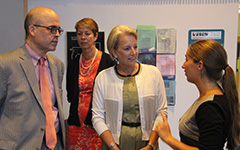
“The competition really helped me take a step back and focus on the larger content of my research and put it in a framework that the general public could understand and get excited about,” says Santos. “The ability to deliver concise and compelling messages about one’s science is a really powerful tool and I’m grateful for the opportunity to work on developing those skills.”
Mamoozadeh also says the competition helped her confidence in explaining her research to a non-technical audience. “The competition makes you think about how to condense the most important aspects of your research into a short, accessible snapshot that allows non-scientists to actually understand what you are doing, and not be intimidated by science,” she says. “I think this helps to reduce public misconceptions about what science is.”
“The goal for the students is to make their science accessible, but not trivialize it,” says Schaffner. “The participants develop a team spirit and give each other advice that really helps elevate the overall quality of the presentations. Regardless of where each student starts off, each one improves by the end of the competition.”
Judges in the final round included VIMS Dean and Director John Wells; W&M Provost Michael Halleran; W&M Board of Visitors member Susan Gerdelman; W&M Associate Vice President for Development Fundraising Earl Granger; and VIMS council members Emily Davies, Casey Duplantier, and Jeanette McKittrick.
Judges for the initial round were VIMS Chief Information Officer Gary Anderson; Coastal Training Program Coordinator Sandra Erdle; Marine Education Program Leader Lisa Lawrence, VIMS extension staff affiliated with Virginia Sea Grant; Chief Financial & Administrative Officer Jennifer Latour; and Chief Operations Officer Joe Martinez.
Presenters and Topics
- Taylor Armstrong: Algae are What They Eat
- Jennifer Beckensteiner: Can TURFs be Used to Surf the Conservation Wave? A Look at Territorial Use Rights for Fisheries
- Sara Blachman: Math with Microalgae
- Isaac Irby: Forecasting the Chesapeake's Future
- Vaskar Nepal KC: Alien Predators: Don't Look Now, but Here They Come
- Nadya Mamoozadeh: Decoding Population Structure: The Magic of DNA
- Joseph Matt: Sex and Money in Oyster Aquaculture
- Bruce Pfirrman: If You Build It, Will They Come? Exploring the Use of Created Oyster Reefs as Habitat by Fish and Blue Crabs
- Qubin Qin: Water Flow Impacts on Phytoplankton Competition and Harmful Algal Blooms
- Bianca Santos: Sea Turtle CSI
- Patricia Thibodeau: The Future of Sea Butterflies in Antarctica
- Zoemma Warshafsky: An Eel's Gotta Deal


